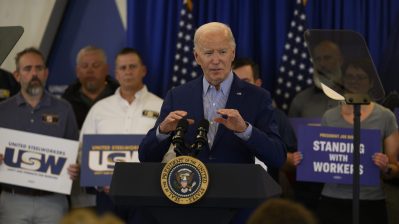Measuring five different Californias
David Brancaccio: Next week, California voters head to the polls for a primary election. The presidential primary is no longer the big thing now that Mitt Romney is set, but there are list of other key votes, including new term limits for state legislators.We think of California as a single state but if you probe the data and look at things like income, education, life expectancy, a more complex picture emerges.
Demographer Sarah Burd-Sharps, co-director of Measure of America, sees five separate Californias — each with its own separate social and economic reality. Good morning, Sarah.
Sarah Burd-Sharps: Good morning David.
Brancaccio: What do you mean Five Californias? It looks like one state to me on the map.
Burd-Sharps: Yep. So we looked at how people were doing all along a spectrum in terms of wellbeing, and we found that it really broke down into five distinct profiles, which we call the Five Californias.
Brancaccio: Like 18 percent are metro, coastal, enclave California — that’s the people who live near L.A., near San Francisco. We have Struggling California — that’s 38 percent of the population. What else do you have?
Burd-Sharps: Well, at the very top we have Silicon Valley Shangri-La, and Shangri-Las in a couple areas in Santa Clara. And then at the very bottom we have the forsaken 5 Percent, which is populations around inner-city L.A. but also the San Joaquin Valley.
Brancaccio: But the biggest population, you call them Mainstream California. There’s a major public policy implication.
Burd-Sharps: Absolutely. They’re sort of the middle class in the popular imagination, and yet, surprisingly, they’re majority minority. And so what we try to say is that understanding the aspirations and the talents of this group is really critical for being able to invest, you know, for California’s entire future.
Brancaccio: So what needs to be done for that group, for instance? What are some recommendations?
Burd-Sharps: Well, one of the things that we found that really surprised us is out of the 2,500 high schools in California, about 100 high schools account for under half the dropouts. So if you want to deal with the dropout problem, you have to focus laser-like on those high schools. In terms of health, the thing that was really surprising to us is that the major gains aren’t really so much from doctors and medicines, but they’re really from the conditions we grow up in. So providing communities with walkability, reducing toxicity in neighborhoods, etc., is really critical.
Brancaccio: Now speaking again of the fancypants part of the California — Silicon Valley, what you call Shangri-La — I assume there are no public policy recommendations. Everything is perfect at that level.
Burd-Sharps: Well, they definitely have all the tools they need in their toolbox to seize opportunities and to live to their full potential. Though one thing that we did find is a tremendous gender wage gap. So among high-wage professional women, these women are earning 49 cents to every dollar that men are earning.
Brancaccio: Forty-nine cents for every buck?
Burd-Sharps: That’s right.
Brancaccio: Sarah Burd-Sharps is co-director of Measure of America. Thank you very much.
Burd-Sharps: Thank you David.
There’s a lot happening in the world. Through it all, Marketplace is here for you.
You rely on Marketplace to break down the world’s events and tell you how it affects you in a fact-based, approachable way. We rely on your financial support to keep making that possible.
Your donation today powers the independent journalism that you rely on. For just $5/month, you can help sustain Marketplace so we can keep reporting on the things that matter to you.


















